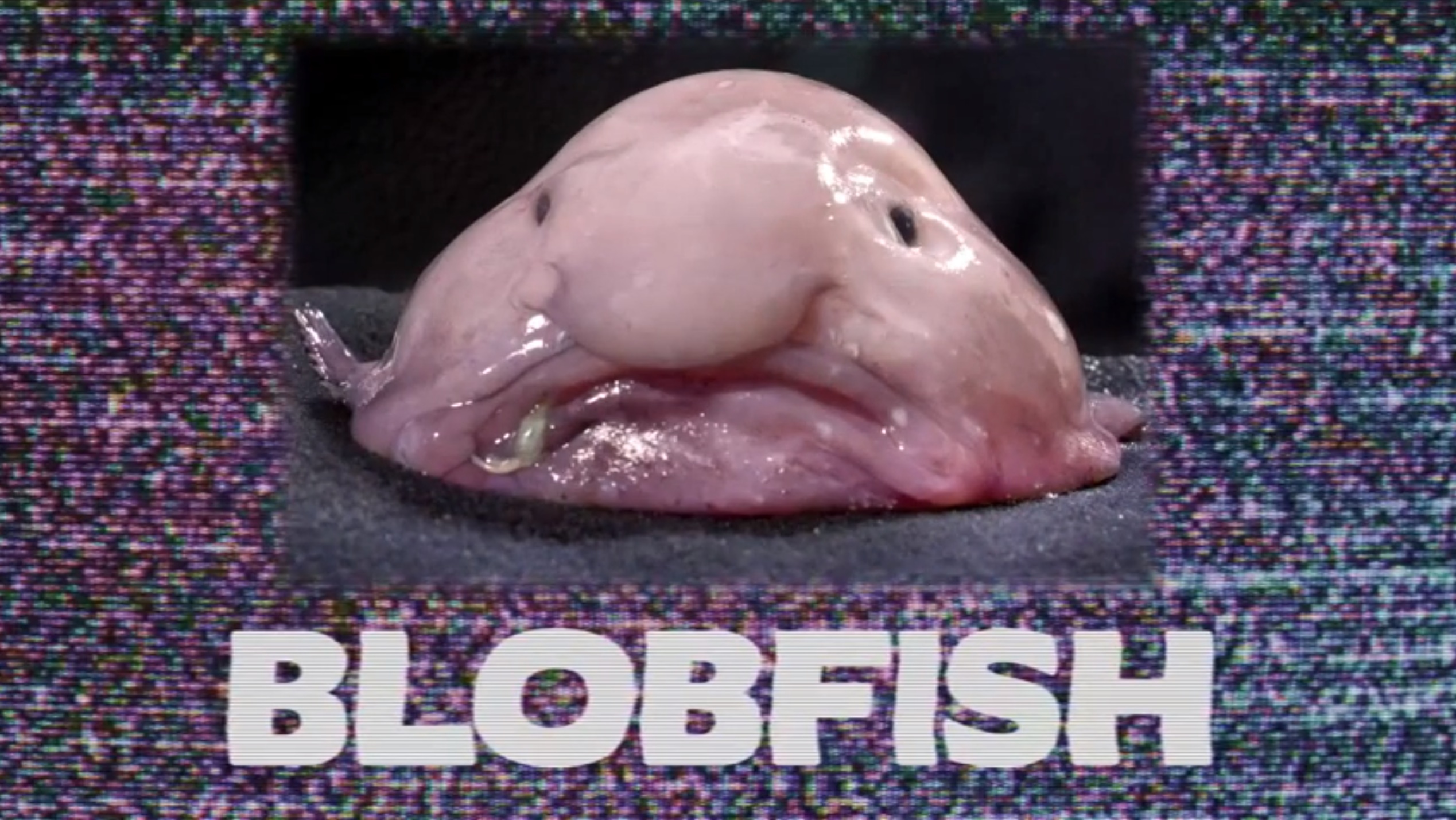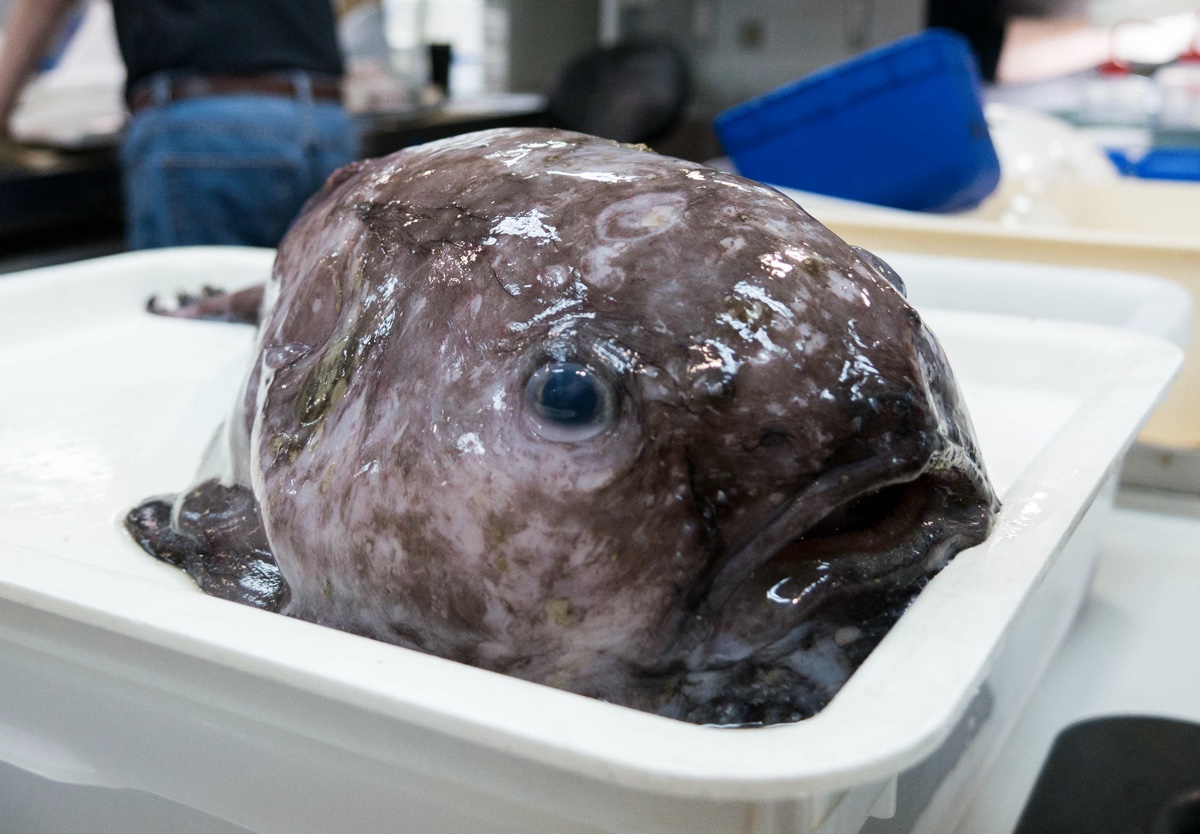What the Heck Is a Blobfish?

The canonical blobfish picture elicits squeals of delight and shudders of horror, embodying an eye-catching blend of cute and ugly somewhat unfamiliar to the Western aesthetic (although it's rather popular in Japan). With its derpy frown, glistening flesh and an impossibly human-looking nose reminiscent of the schnoz on Ziggy and Kilroy drawings, the fish was an internet star just waiting to happen.
While these days the blobfish has enough face recognition to make other arguably more charismatic creatures envious, researchers know very little about this enigmatic species. Scientists must infer how it spends its days and what it eats from the physical characteristics of the blobfish's environment and the biological features of fellow deep-sea fish. Ironically, the animal's marquee feature — its signature flab — is not what sets it apart; rather, that's a commonality the fish shares with many other denizens of the deep.
The most famous blobfish: Mr. Blobby
References to the fish family known as fathead sculpins (Psychrolutidae) first appeared in the scientific literature more than 150 years ago, but the specific individual destined for viral internet fame surfaced in 2003. Researchers collected and photographed "Mr. Blobby," as they nicknamed him, along with many other marine species during the Australian-New Zealand NORFANZ research voyage. While trawling the ocean to conduct a biodiversity census, the crew netted Mr. Blobby at a depth of between 3,323 and 4,396 feet (1,013 to 1,340 meters) somewhere between New Caledonia and New Zealand, according to the Australian Museum, where the fish currently resides as a specimen.
Mr. Blobby languished in relative obscurity for about a decade, until The Ugly Animal Preservation Society thrust him into the international spotlight when the fish won the group's 2013 competition to select the world's ugliest animal. Organized by comedian and science communicator Simon Watt, the stunt aimed to draw attention to less-fetching members of the animal kingdom ("The Ugly Animals: We Can't All Be Pandas" (The History Press, 2014) reads the title of the society's book). Mr. Blobby bested nearly a dozen other species including the axolotl and the proboscis monkey, garnering more than a quarter of the 3,000 votes cast. In recent years, the fish's fame has continued unabated, with the animal appearing in commercials, on the television show "Saturday Night Live" and in more than one political meme.
Life under pressure
Beyond the droopy scowl, researchers know surprisingly little about the fish that made such an internet splash. The Psychrolutidae family contains eight genera and more than 30 species, of which the flagship might be the species represented by Mr. Blobby: Psychrolutes microporos. Each species tends to live in a relatively concentrated area (P. microporos is found exclusively between Australia and New Zealand), but other members of the family crawl the floors of the Atlantic, Pacific and Indian oceans.
Bumbling along the bottom, thousands of feet beneath the waves, the blobfish's world is cold, dark and empty. The water presses in on animals there with more than 100 times the atmospheric pressure we feel on land, making the compressible swim bladders that many surface fish use to control their buoyancy less practical for these deep-sea creatures. Rather, natural selection has equipped the blobfish with exclusively incompressible parts, such as water-filled cells and organs not unlike most of our own. This construction makes the fish neutrally buoyant, neither rising nor sinking, which lets them float motionlessly as they wait for prey, such as snails and other bottom dwellers.
"They'll feed on whatever they're able to opportunistically take in as a meal," said Martin Gomon, an ichthyologist at the Museums Victoria in Australia. "Probably, based on the size of the mouth, one would guess that they're feeding on invertebrates that live right on the bottom."
Far removed from the life-supporting rays of the sun, deep-sea fish live in a world devoid of many food options, which means that energy efficiency is key to survival. As such, many deep-sea dwellers eschew oxygen-burning muscles and the strong, calcium-dense bones found in their shallower-dwelling and more-athletic cousins, such as tuna or swordfish. Deep-sea fish lead more lethargic lives, moving slowly and only when absolutely necessary. Without the developed musculature of surface fish, Psychrolutidae bob along the bottom, unperturbed by the relentless pull of gravity that dogs us up on the surface — until they are hauled up by a trawler and their delicate countenance melts into a permanent pout.
"You'll find that many of these animals living down there do not have a lot of hard structures," Gomon said. Although he has never handled a blobfish in its natural environment, he said that, in our world, the consistency of a blobfish resembles something like jello. "They are quite flabby."
In other words, Mr. Blobby had a serious advantage in the 2013 ugliest animal competition, one that most deep-sea fish would have shared if pulled from the ocean's supportive environment and left to sag in the air. When swimming a few thousand feet below the water's surface, blobfish look rather handsome, and much more like normal fish.

Protected by the deep sea
Aside from what researchers can infer from the few samples collected, nearly everything else about blobfish remains a mystery. "Their general biology would be one of the biggest questions," Gomon said. "We just don't know that much about them."
And scientists aren't likely to learn much more anytime soon. A blobfish-oriented research expedition would be "a very expensive proposition," Gomon said, "just because of the depth they occur in."
This separation of worlds may benefit the blobfish in the end. A habitat that's challenging to reach is also challenging to disturb, and the thousands of feet of water above the animals' soft heads may protect these strange creatures from the threat of extinction many surface animals face. Of the six species in the Psychrolutidae family that appear on the International Union for Conservation of Nature's Red List, four fall into the "least concern" category and two into the "data deficient" column, which means that there isn't enough information to decide their status.
For now, we'll just have to marvel at the rare glimpse into the alien world of the deep ocean brought by this unlikely ambassador. The little scientists know about the blobfish reflects how little they know about most deep-sea dwellers, Gomon said. "We are only just scratching the surface with regard to the understanding of deep-water communities and the animals that are living in them."
Additional resources:
- Read more about Mr. Blobby from the Australian Museum.
- Listen to a podcast about blobfish from the National Marine Fisheries Service.
- Watch this video of blobfish in their deep-sea home, filmed by the E/V Nautilus.
Sign up for the Live Science daily newsletter now
Get the world’s most fascinating discoveries delivered straight to your inbox.

Charlie Wood is a staff writer at Quanta Magazine, where he covers physics both on and off the planet. In addition to Live Science, his work has also appeared in Popular Science, Scientific American, The Christian Science Monitor, and other publications. Previously, he taught physics and English in Mozambique and Japan, and he holds an undergraduate degree in physics from Brown University.










